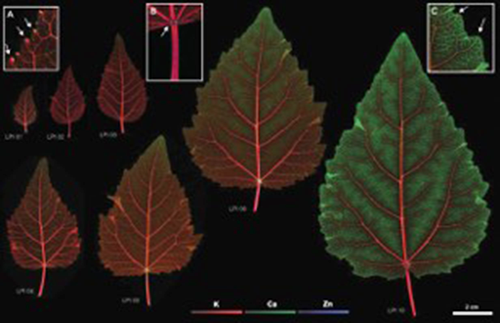X-RAY RUNS: Apply for Beamtime
2017 Nov 1 - Dec 21
2018 Feb 7 - Apr 3
2018 Proposal/BTR deadline: 12/1/17
2018 Apr 11 - Jun 4
2018 Proposal/BTR deadline: 2/1/18
It is well known that plants, like animals, must constantly regulate and transport nutrients to survive. For example, the leaves of many plant species begin life as net nutrient sinks: that is, they rely on carbohydrates and other nutrients transported from elsewhere in the organism. As photosynthesis rates rise, leaves ultimately become net nutrient sources, supplying carbohydrates to the remainder of the plant. This sink-to-source transition is likely to have profound effects on mineral distribution, sequestration, and compartmentalization of essential elements in plants. But determining these effects is challenging due to the difficulty in measuring such distributions over large areas, such as a whole leaf or plant.
In a new article in the Journal of Experimental Biology (doi:10.1093/jxb/erw111), Cornell University graduate student Monica R. Carvalho demonstrates the use of large-area x-ray fluorescence mapping with the 384-element Maia detector (described further here and here) to explore just this question. The paper, entitled, “Spatiotemporal distribution of essential elements through Pupulus leaf ontogeny,” describes calcium, potassium, and zinc concentration maps obtained from XRF scans of a series of seven poplar leaves varying in age and size and spanning the transition from sink to source. The calcium distribution in particular exhibits a striking change as a function of leaf age, and in a manner consistent with other physiological changes known to be associated with this transition.
Plan-view XRF maps such as those in Figure 1 were obtained primarily at F3 station, from oven-dried leaves with a 0.02 mm focused beam. Critical information about the localization of elements within leaf tissues was obtained from additional XRF maps, obtained from hydrated leaf cross-sections with 0.01 mm spatial resolution.
Inquiries about XRF mapping at CHESS should be directed to Arthur Woll (arthurwoll@cornell.edu) or Rong Huang (rh66@cornell.edu).

Figure 1: False color representation of elemental distributions of potassium (red), Calcium (green) and Zinc (blue) in a series of poplar leaves of increasing age and size. Inserts highlight areas characterized by high Ca and Zn concentration in (A) teeth apices in the youngest leaf LPI01 and (B) leaf base in the 2nd-youngest leaf LPI02, and the absence of this feature in the oldest leaf LPI10.
Submitted by: Arthur Woll, CHESS, Cornell University
04/15/2016
